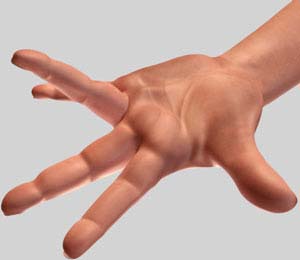
What is Dupuytren’s Contracture?
Dupuytren’s contracture is a hand condition where thickening of the underlying fibrous tissues of the palm causes the fingers to bend down. This makes it difficult to fully straighten the affected fingers. It most commonly occurs in the ring and little fingers, but occasionally other fingers may be affected.
Causes of Dupuytren’s Contracture
Dupuytren’s contracture is caused from excessive production of collagen which is deposited under the skin. The cause of Dupuytren’s contracture is unknown. However, there are certain risk factors that may increase your chances of developing the condition. These can include the following:
- Age: More frequently around age 40
- Social habits: Smoking and drinking alcohol
- Medical conditions: Diabetes, alcoholism, cirrhosis of the liver and seizure disorders
- Gender: More common in males than females
- Heredity: Condition tends to run in families
- Ancestry: Most commonly affected are northern Europeans and people of Scandinavian descent
Symptoms of Dupuytren’s Contracture
Dupuytren’s contracture is a condition that usually progresses over time and is not painful. Some cases may progress more rapidly and while others progress quite slowly. The most commonly observed symptoms of Dupuytren's contracture are the development of lumps or nodules in the palm of the hand, difficulty in straightening the fingers and contracture of the nodules which form tough bands or cords under the skin.
Diagnosis of Dupuytren’s Contracture
Dupuytren's contracture is diagnosed based on your history and a physical examination, without the need for any special tests. The physical examination may involve applying pressing on different parts of your hands and fingers to assess for hardened knots or tough bands of tissue.
Conservative Treatment for Dupuytren’s Contracture
You may not need any treatment for Dupuytren’s contracture if the condition is not affecting your ability to perform daily activities. However, if you are having difficulty using your hands for everyday activities, your surgeon may recommend conservative treatment options to treat your condition. Treatment options will vary depending on the severity of your condition. The conservative approaches include:
- Heat: Applying heat to the palms of your hand prior to massage or exercise can help to loosen the tissues.
- Massage: Gently massage the thickened tissues of the palm.
- Exercises: Stretching exercises such as bending the fingers away from the palm may be useful.
- Collagenase injection: An enzymatic drug that breaks down collagen can be injected into the corded tissue to soften and weaken the contracture. The physician then manipulates the area manually to break up the tissue.
- Needle aponeurotomy: This procedure involves inserting a small needle into the thickened palm tissue and manipulating it to loosen and break up the contracting tissue.
Surgical Procedure for Dupuytren’s Contracture
If conservative treatment options fail to resolve the condition and your quality of life is adversely affected, your surgeon may recommend a surgical procedure to remove the diseased tissue and release the contracture.
This surgery is performed in an operating room under local or regional anesthesia on an outpatient basis as day surgery. Your surgeon makes an incision over the affected area in the palm and/or finger. Occasionaly, multiple incisions are necessary. Your surgeon then removes the thickened fibrous tissue causing the contracture. The incision is then fully or partially closed with sutures and covered with a sterile dressing. Frequently, portions of the skin are left open to accommodate the new straightened position of the fingers. These areas will heal themselves over a couple of weeks.
Complications following Surgery for Dupuytren’s Contracture
Some of the complications associated with dupuytren’s surgery include:
- Nerve damage causing a loss of feeling in the affected finger
- Injury to the arteries of the fingers/hand
- Infection
Recurrence of the condition
Related Topics
- Wrist Fracture
- Fractures of the Hand and Fingers
- Wrist Sprain
- Flexor Tendon Injuries
- Distal Radioulnar Joint (DRUJ) Arthritis
- Ulnar Nerve Compression in Guyon's Canal
- Scaphoid Facture
- Industrial Hand Trauma
- Distal Radius Osteotomy to Correct Mal-Union (Crooked Painful Wrist)
- Distal Intersection Syndrome
- Distal Biceps Avulsion
- Adult Forearm Fractures
- Arthritis of the Hand and Wrist
- Arthritis of the Thumb
- Ganglion Cyst
- Boutonniere Deformity
- Carpal Tunnel Syndrome
- De Quervain's Tendinosis
- Dupuytren's Contracture
- Hand Pain
- Hand Infections
- Trapeziometacarpal (TMC) Arthritis
- Wrist Injuries
- Wrist Tumors
- Boxer's Fracture
- Swan Neck Deformity
- Carpal Instability
- Bennett's Fracture
- Kienbock's Disease
- Scapholunate Dissociation
- Triscaphoid Joint Arthritis
- Ulnar Carpal Impaction
- Triangular Fibrocartilage Complex Injury (TFCC)
- Guyon's Canal Syndrome
- Hand Masses
- Distal Radioulnar Joint (DRUJ) Instability
- Work Related Hand Injuries
- Wrist Ligament Tear and Instability
- Metacarpophalangeal Joint Arthritis





